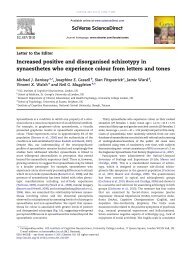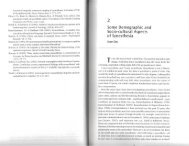A strong parietal hub in the small-world - Synesthesia
A strong parietal hub in the small-world - Synesthesia
A strong parietal hub in the small-world - Synesthesia
You also want an ePaper? Increase the reach of your titles
YUMPU automatically turns print PDFs into web optimized ePapers that Google loves.
Small-<strong>world</strong> network of coloured-hear<strong>in</strong>g synaes<strong>the</strong>tes 183<br />
images represent <strong>the</strong> standardized electric activity expressed as <strong>the</strong> exact magnitude of<br />
<strong>the</strong> estimated current density at each voxel <strong>in</strong> <strong>the</strong> MNI space (Montreal Neurological<br />
Institute). Anatomical labels (as Brodmannn areas) are also reported us<strong>in</strong>g MNI space,<br />
with correction to Talairach space (Brett, Johnsrude, & Owen, 2002). sLORETA ‘solves’<br />
<strong>the</strong> <strong>in</strong>verse problem by tak<strong>in</strong>g <strong>in</strong>to account <strong>the</strong> well-known effects of <strong>the</strong> head as a<br />
volume conductor. Conventional LORETA and <strong>the</strong> more recent sLORETA analyses have<br />
been frequently used <strong>in</strong> previous experiments to localize bra<strong>in</strong> activations on <strong>the</strong> basis<br />
of EEG or MEG data (Langer, Beeli, & Jäncke, 2010; Meyer, Baumann, & Jäncke, 2006;<br />
Mulert et al., 2004; Zaehle et al., 2009).<br />
Graph-<strong>the</strong>oretical network analysis<br />
A graph-<strong>the</strong>oretical network analysis was conducted to analyse connectivity parameters<br />
for <strong>the</strong> <strong>in</strong>tra-cerebral bra<strong>in</strong> oscillations on <strong>the</strong> basis of <strong>the</strong> <strong>in</strong>tra-cerebral oscillations.<br />
Several studies conclude that an <strong>in</strong>tra-cortical approach represents a clear methodological<br />
improvement compared to <strong>the</strong> EEG spectral analysis at surface electrodes (Babiloni et al.,<br />
2004; Lehmann, Faber, Gianotti, Kochi, & Pascual-Marqui, 2006; Mulert et al., 2004;<br />
S<strong>in</strong>ai & Pratt, 2003). Two-second epochs of EEG-data of each subject were imported <strong>in</strong>to<br />
<strong>the</strong> sLORETA software. With<strong>in</strong> <strong>the</strong> sLORETA analysis framework, coherence between 84<br />
anatomical regions of <strong>in</strong>terest (ROI) <strong>in</strong> both hemispheres was computed. Coherence was<br />
calculated as l<strong>in</strong>ear <strong>in</strong>stantaneous connectivity. This measure was used <strong>in</strong> o<strong>the</strong>r studies<br />
before (De Vico Fallani et al., 2010) and is deemed an adequate measure for comput<strong>in</strong>g<br />
rest<strong>in</strong>g state networks. L<strong>in</strong>ear <strong>in</strong>stantaneous connectivity is a function that operates <strong>in</strong><br />
<strong>the</strong> frequency doma<strong>in</strong> and generates a value between 0 and 1. Given two signals x and y,<br />
<strong>the</strong> l<strong>in</strong>ear <strong>in</strong>stantaneous connectivity is calculated <strong>in</strong> a particular frequency f by tak<strong>in</strong>g<br />
<strong>the</strong> square of <strong>the</strong> cross-spectrum<br />
|Sxy( f )| 2<br />
and <strong>the</strong> divid<strong>in</strong>g by <strong>the</strong> product of <strong>the</strong> two correspond<strong>in</strong>g auto power spectra:<br />
SCxy( f ) = |Sxy( f )| 2<br />
Sxx( f )Syy( f ) .<br />
In <strong>the</strong> present study, <strong>the</strong> l<strong>in</strong>ear <strong>in</strong>stantaneous connectivity SC is calculated between<br />
<strong>the</strong> signals of each cortical source ROI. The sLORETA head model, a standardized<br />
template <strong>in</strong> MNI space <strong>in</strong>clud<strong>in</strong>g cortical areas of <strong>the</strong> bra<strong>in</strong>, was parcellated <strong>in</strong>to 84<br />
Brodmann areas to compute <strong>the</strong> coherence between <strong>the</strong> centre voxels of each of <strong>the</strong><br />
84 ROI. We chose to use <strong>the</strong> centroid voxels of each ROI <strong>in</strong>stead of calculation of<br />
average coherence measures of each ROI, because sLORETA estimates <strong>the</strong> solution<br />
of <strong>the</strong> <strong>in</strong>verse problem based on <strong>the</strong> assumption that <strong>the</strong> smoo<strong>the</strong>st of all possible<br />
activation distributions is <strong>the</strong> most plausible one. This assumption is supported by<br />
neurophysiological data demonstrat<strong>in</strong>g that neighbour<strong>in</strong>g neuronal populations show<br />
highly correlated activity (Michel et al., 2009). Because of <strong>the</strong> assumptions of sLORETA,<br />
signals of spatially adjacent voxels of neighbour<strong>in</strong>g ROIs are highly correlated, <strong>in</strong>duc<strong>in</strong>g<br />
larger coherence, which might be not physiological <strong>in</strong> nature. By tak<strong>in</strong>g just <strong>the</strong> s<strong>in</strong>glecentre<br />
voxel of each ROI, we could exclude such contam<strong>in</strong>ation. Because of <strong>the</strong> spatially<br />
smooth <strong>in</strong>verse solution of sLORETA, <strong>in</strong>formation of <strong>the</strong> centroid voxel is an accurate<br />
representative for activity with<strong>in</strong> <strong>the</strong> ROIs.<br />
Intra-cerebral coherence measures of 84 ROIs were subjected to graph-<strong>the</strong>oretical<br />
network analysis. The <strong>in</strong>put for this analysis consisted of an 84 × 84 coherence-matrix




